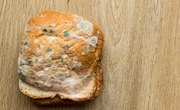
Few organisms are as universally disliked as mold. Nobody wants to reach into the fruit bowl or the onion bin and pull out a food item covered with the characteristic fuzz that lets you know your food has begun to decompose. It might be surprising, however, to discover that some molds play important roles in food production. In fact, one of the most common ingredients in Western food products actually derives from one of the most notoriously maligned fungi: black mold, known by scientists as A_spergillus niger_.
TL;DR (Too Long; Didn't Read)
Aspergillus niger, or black mold, is a common fungus that appears on decomposing starchy fruits and vegetables as well as on damp walls as a component of mildew. This organism plays an important role in food science, including the production of citric acid, which serves as a preservative and flavoring agent for soft drinks like soda. The next time you drink a soda, remember the black mold that made it possible!
Meet Aspergillus Niger
Microbiologists recognize the Aspergillus family of molds by its characteristic shape: a thin stalk with a round conidial head made up of spores, which bud from the organism’s body as part of asexual reproduction. In fact, the mold even derives its name from its appearance since it resembles the holy water sprinkler used by priests, called an aspergillum.
Of course, non-microbiologists tend to call aspergillus by its common name – black mold – and few fungi inspire the anxiety that this one does. Although members of the aspergillus family are very common and easily identified on starchy fruits and vegetables that are overripe as well as on damp surfaces where it is a component of mildew, the organism has the potential to cause health issues for humans who come into contact with it. This condition, generally called aspergillosis and referring to a cluster of related illnesses, usually brings symptoms such as coughing and difficulty breathing. However, these health issues only affect people with pre-existing respiratory conditions such as asthma or cystic fibrosis, or who have compromised immune systems.
Aspergillus Uses in Food Production
When you look at a food label, you might see many ingredients that sound familiar such as gluconic acid and citric acid. However, you probably never suspected that these ingredients show up in your food thanks to black mold. Food scientists and producers use one member of the aspergillus family, Aspergillus niger, to make ingredients you can find on many food labels, including gluconic acid and citric acid. Gluconic acid regulates the acidity of food products like wine and is a natural preservative. This means it helps prevent the food product from decomposing or breaking down inside the packaging.
The other common ingredient, citric acid, is also a preservative, but its most common use concerns your taste buds. Citric acid gives soft drinks like soda their characteristic flavor. While it is true that citric acid is present in citrus fruits, almost all of the citric acid used today relies on the ability of aspergillus to ferment. To do this, scientists feed sugar or molasses to Aspergillus niger and then collect the citric acid that the combination produces as a product of fermentation. Fortunately, microbiologists only harvest the citric acid and not the black mold itself, so the foods and drinks that require citric acid are completely safe to consume, even for people with mold allergies or who are at risk for aspergillosis.
For most people, the connection between black mold and common food products like soda is a true surprise. After all, you probably think mold is gross since it signals decaying food or dirty shower walls. However, aspergillus uses in the food industry, including citric acid collection, are a virtually unavoidable part of modern Western food production and may even inspire a new appreciation for the fungus among us.
References
About the Author
Melissa Mayer is an eclectic science writer with experience in the fields of molecular biology, proteomics, genomics, microbiology, biobanking and food science. In the niche of science and medical writing, her work includes five years with Thermo Scientific (Accelerating Science blogs), SomaLogic, Mental Floss, the Society for Neuroscience and Healthline. She has also served as interim associate editor for a glossy trade magazine read by pathologists, Clinical Lab Products, and wrote a non-fiction YA book (Coping with Date Rape and Acquaintance Rape). She has two books forthcoming covering the neuroscience of mental health.
Photo Credits
mold image by Dave from Fotolia.com
